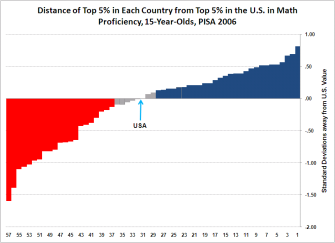skoolboy has always found Olympic medal counts by country to be silly. Sure, it’s fine to take pride in the accomplisments of one’s countrymen and countrywomen. But the Olympics for me are about appreciating excellence, regardless of the flag (or swoosh) on the uniform.
Ah, but student achievement! That’s a horse race of a different color. We have a venerable tradition dating back at least to A Nation at Risk of comparing the academic achievement of U.S. schoolchildren to the performance of kids in other countries. The Olympics serves as a quadrennial site for seeing how we measure up to other countries.
Yesterday, eduwonkette decried former West Virginia governor Bob Wise’s comparison of the relative performance of elite U.S. athletes against the world in the Olympics with the relative performance of average U.S. students against the world in high school graduation rates. Aren’t our elite students doing just as well as those in other countries?, she asked.
skoolboy doesn’t have the performance of elite students cued up for comparison, but here are some data from the 2006 Programme for International Student Assessment (PISA), an international survey of 15-year-olds in 57 countries. The figures below show the performance achieved by students at the 95th percentile--that is, the top 5%--in each country. The countries are arrayed from lowest achievement to highest on the PISA assessments, with each column representing a country. Dark blue columns are countries scoring significantly higher than the U.S. Grey columns are statistically indistinguishable from U.S. performance, and bright red columns are countries doing worse than the U.S. The length of the column represents how far away a country is from the U.S. based on the standard deviation of individual scores around the world.
In mathematics, the performance of top U.S. students is dismal. In 28 countries, students at the 95th percentile score significantly higher than students at the 95th percentile in the U.S., and the gaps are surprisingly large. Students in Chinese Taipei, Korea, Hong Kong, Switzerland, Finland, Belgium, the Czech Republic and Liechtenstein all score at least .5 standard deviations above the U.S. in this comparison.

Things look a little bit brighter in science achievement. Ten countries have students at the 95th percentile scoring higher than the U.S., and 35 countries have students at this level scoring significantly worse than U.S. students at the 95th percentile. Eleven countries are statistically indistinguishable from the U.S. Still, the best that we can claim is that the U.S. is tied for 11th internationally, although the magnitude of the gap between U.S. elite students and elite students in the top-ranked countries (e.g., Finland, New Zealand, the United Kingdom, Australia and Japan) is smaller in science than it is in math.

These comparisons don’t address the performance of students entering the most selective of U.S. colleges and universities--the MIT’s, Cal Techs, Harvards, Princetons and Yales. In a national cohort of 3 million 15-year-olds, the top 5% is 150,000 students, and the vast majority of these are not entering the most selective colleges. Still, the fact that the top 5% of U.S. students are getting their butts kicked in math and science is alarming to those who tie U.S. global competitiveness to the academic performance of American youth. Just as in sport, there are no quick fixes: a well-planned training regimen (including plenty of time in the academic weight room) is the key to success.

